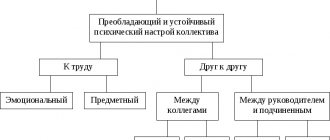Adviсe
- Psychological climate in the team. Basic Concepts
- Factors influencing the psychological climate in a team
- Social tension in the organization. Strategies to reduce
- How to improve the psychological climate in a team
Everyone would like to find a job where they pay well, the team is pleasant, there is no overtime, and the entire social package is available. Such information is indicated in almost 99% of resumes on various job search resources. But employers offer fewer benefits, but many requirements with little pay. Of course, it is also important for them to find a suitable candidate, and also to achieve high productivity with minimal effort on their part.
Positive sentiment among employees always has a positive impact on the work process and productivity.
Large companies successfully apply the principle of working with employees not only to improve their skills, but also to normalize the psychological climate in the team. Unfortunately, many medium and small companies do not pay attention to this problem, which becomes the cause of many difficulties.
Definition of the concept
What is the psychological climate in a team? This is the moral and psychological situation in the group. It is detected and manifested primarily in the emotional sphere: the mood of each participant, the system of likes and dislikes, the moral values of each member of the group. What else determines the psychological climate in a team? Through it, the attitudes and habitual patterns of behavior of the participants are determined and reflected, including the usual ways of achieving personal and common goals, building relationships, resolving conflicts, etc.
In Russian psychology, the concept of “psychological climate in a team” was introduced by psychologist N.S. Mansurov (late 50s - early 60s of the XX century). However, in psychology there is still debate about the identity of the terms “psychological climate” (PC), “socio-psychological climate” (SPC) and “moral-psychological climate” (MPC). Most psychologists believe that they are one and the same thing. Other experts see the difference in emphasis and continue their research. In short, the following features of the concepts are highlighted:
- PC reflects the specifics of the individual’s interaction with the social environment (work collective) and with the physical environment (working conditions). This concept is more often used when describing and studying the mental state of individual team members.
- SPC reflects the specifics of the individual’s interaction with the social environment. This concept is more often used when describing the interpersonal relationships of team members.
- The IPC reflects the characteristics of the attitude of team members to each other, work and life of the organization based on personal values. This concept is more often used to describe how the well-being of each of the participants affects their productivity, relationships with other team members and attitude towards work.
Some psychologists, for example, G.A. Vinogradov distinguishes additional types of PC (besides those that we have already considered): emotional-psychological and moral-psychological climate. In this article we will not delve into the intricacies of concepts and will consider the phenomenon in general terms - the psychological climate in a team. And we will consider the SPK and IPC as components of the PC.
Important! The mood, attitudes, values, beliefs, and interests of team members influence the PC, but at the same time, the PC (general atmosphere) influences the mood, attitudes, and values of individual team members.
Characteristics of the term
Each person interacting with other people creates an objective and subjective reflection of the situation. Objective situations include awareness of social relations: hierarchy, tasks of an individual representative of society, level of responsibility. The socio-psychological climate in a team is a subjective concept that depends on a number of factors, including:
- group interaction style;
- perception of urgent work, ways to achieve specific goals;
- level of complexity of the presented tasks;
- degree of emotional stability of team members;
- compatibility of team representatives in terms of psychological qualities;
- customs, affairs, general thinking.
Psychologists classify 2 components of the concept of socio-psychological climate:
- Social aspect. Interpersonal relationships in the professional field, the difficulty of work, the scheme of rewards and punishments.
- Moral aspect. Consonance of moral standards, group community, the possibility of informal communication, team relationships.
The combination of these components determines the overall climate and its impact on team members. Due to the combination of subjective perceptions, it is subject to influence - change, improvement.
Climate structure
The structure of the climate in the workforce includes two elements:
- Relationship between people.
- Attitude to work.
Interpersonal relationships are of two types (branch to the side in the structure):
- horizontal relationships, that is, between subordinates;
- vertical relationships, that is, between subordinates and superiors.
Each of the three types of relationships affects team cohesion, employee satisfaction and their motivation to continue working in this team.
Welcome feedback
Of course, a leader must have a high degree of personal awareness in order to create a climate in which his employees want to work actively and productively. Sometimes a manager should turn to an external coach, but one of the most effective tools is feedback, which must be individual in relation to the subordinate. It is important to agree on truly open and constructive feedback, not just socially desirable comments or emotional criticism.
Feedback is an exchange of opinions and observations, expressing one’s position on management decisions, interaction with the team, and in general about everything that affects both the emotional component and efficiency. It gives results if both parties are committed to an honest dialogue.
The basic rules of feedback are to start with the positive, then discuss areas of development and, without getting too personal, what you are not happy with, and also end with positive feedback. Teach your subordinates that it is possible and necessary to speak openly about problems that concern them. True, in this case you need to be prepared for not the most pleasant news.
Favorable and unfavorable climate
PC can be favorable or unfavorable. In the first case, all participants feel good, and the common cause is going well. In the second case, you can feel the intensity of emotions in the team, conflicts often arise, and the participants are stressed.
Let us consider in the form of a comparative table what is typical for the two types of psychological climate.
| Comparison criterion | Favorable climate | Unfavorable climate |
| Mood | Optimistic | Pessimistic |
| Cohesion | Group members support each other, help each other | There is disunity, envy, hatred |
| The nature of interpersonal relationships | All participants are friendly | Aggressive behavior predominates |
| Working atmosphere | Everything works out easily and naturally, all employees are aimed at success and put forward adequate demands on each other | There is tension in every action, there is fear of punishment, team members are too demanding of each other or, conversely, there is permissiveness |
| Communication | Team members interact openly with each other | Each of the participants is concerned only with their own problems, is cold towards others, closed |
We are constantly monitoring the situation
The climate within the same team changes over time. This may be due to the external environment - for example, during a crisis, all relationships become strained, much more effort is required from the team, and fear of dismissal arises.
The situation within the team can also change, since the emotional background directly depends both on the leader, who may have different periods in his life, and on the team members, whose life situation, emotional background, roles and positions, goals and priorities may also change. .
It is important for a manager to constantly keep his finger on the pulse, communicate with the team, receive feedback and be ready for changes.
In any case, every person should look for a team in which he will feel comfortable and direct all his energy to achieving results. And the leader needs to spend time to form a team in which all participants will complement each other and will be able to maintain a creative rather than destructive climate.
Levels
In psychology, it is customary to consider the psychological climate at two levels (two types):
- Static level. This is that part of the climate that is determined by the stable characteristics of the team: the system of likes and dislikes, attitude towards work, values and beliefs of employees. This level of climate is resistant to the influence of negative external factors. Reaching this level is the height of mastery. A static climate is typical for older groups, but even such groups do not always manage to reach this level.
- Dynamic level. This is the part of the climate that changes daily and depends on mood, current life problems and important events in the lives of workers. This level is typical for fresh, young teams. However, even in an old team there can be a dynamic, that is, unstable climate. He is weak to the influence of external factors.
In a static climate, participants feel safe. At the dynamic level there is tension, a feeling of instability.
Signs
To diagnose the state of the psychological climate in the group, special psychological tests were developed (we will talk about them in the “Diagnostics” section of this article), but besides this, the psychological climate in the team is determined by external general signs.
Signs of an unfavorable psychological climate:
- high staff turnover;
- low quality product;
- frequent accidents at work;
- negative feedback from employees.
Signs of a favorable psychological climate in a team:
- democratic leadership style;
- an adequate system of punishments and rewards;
- constructive criticism;
- mutual assistance and a high level of empathy;
- a sense of group cohesion and responsibility for oneself and the entire production;
- positive feedback from employees.
The psychological climate is influenced by personal and collective factors. Let's take a closer look at them.
Recommendations
- Highlight informal leaders, give them more power and encouragement, because they are the ones the team trusts, it is their opinion that the team will support, and seek help if difficulties arise. Therefore, if the unspoken leader respects and values you, then when collaborating with him, you can be sure that everyone else will share his opinion, with the exception of special instances. And to become the most chosen group, look at the article about ways to develop leadership qualities in yourself.
- For conflict resolution, see this article.
- If you manage to establish relationships with employees, do not forget about such a nuance as maintaining the created atmosphere in the group. As they say: “To break is not to build.” So try not to devalue or invalidate all your efforts. Literally one mistake at first will be enough for everything to go back. If you have changed your approach to colleagues and the work process, then no matter how you are provoked to return to a more familiar system, do not give in. Criticism and punishments must be fair so that no one can doubt your competence. Be sure to look at the rules and techniques listed here.
- Show by your own example how to talk to colleagues, support and help. If you are a leader, then prove that you trust your subordinates. Try to loosen control, give a more serious task and provide an opportunity to demonstrate your abilities by seeking advice in solving a difficult issue.
- Managers are not gods, no matter how geniuses they are, which is why they may well make mistakes. It is important to only be able to apologize to your subordinates; this will not make you weak, but on the contrary, it will strengthen your authority and show that you are also a living person. Learn, if you don’t know how, to make concessions and seek compromises with people, even those of lower rank.
- Choose your leadership style depending on the situation and environment. If you are authoritarian, then at the moment when the situation in the team reaches its peak, you risk receiving a lot of resignation letters, or, in extreme cases, frame-ups, slander, etc. Look at the model that scientists have developed for the very purpose of learning to determine when and how to behave.
Factors influencing climate
Personal factors influencing the psychological climate in the organization:
- Job satisfaction. Some people like the same type and monotonous activities. Some people need activity and multitasking. Some are more diligent, others less. Some are masterfully creative, while others work perfectly according to instructions. Work tasks must correspond to the characteristics of the individual, then the person will be satisfied with himself, and this, in turn, affects the creation of a favorable psychological climate in the team.
- Career prospects. Of course, there are people who are comfortable being in the same position for many years, receiving the same salary. But most people are interested in career growth. This increases motivation, as does an adequate system of rewards and punishments. The more freedom, rights, and opportunities employees have, the more favorable the psychological climate in the team.
- Convenient workplace. And we are talking not only about physical convenience, but also about psychological comfort. Some people can only work in silence, while others find it important to constantly discuss issues with colleagues. Some people need privacy, while others cannot work alone. Some people can't stand the heat, and some people can't stand air conditioning, etc. Working conditions must correspond to the needs and characteristics of the employee, then he will be satisfied and happy, which, in turn, has a positive effect on the general psychological climate in the team.
- Personal time. The importance of weekends and working strictly according to schedule cannot be underestimated. If there are overtimes or work on days off, then this must be paid and compensated next time. Employees should have a personal life, the opportunity to make plans, and spend time with friends or family. The right to privacy contributes to the creation of a favorable psychological climate in the team.
- Microclimate in the family, features of the personal life of employees. Problems in the family or worries due to loneliness cannot but affect the employee’s mood. Later he will bring the negative with him to production. For this reason, large companies organize family vacations, sponsor trips to a sanatorium for the children of employees, etc. Employers try to take care not only of the health and happiness of employees, but also of the well-being of their families.
Work strategies
Preventive methods
- It is important to take into account the psychological characteristics of each person when hiring. Therefore, if during the interview some points made you wary, think carefully about whether it is worth letting such a person into your company. Objectively evaluate all the consequences of the manifestation of her character, no matter how professional in her field or close relative she may be.
- Certification of employees should be periodically carried out, especially those who have even a minimum number of people subordinate to them.
- Strict control of the number of employees and vacancies. If there is a shortage, some of the responsibilities have to be distributed among all members of the group, or assigned to one person. And this always threatens the emergence of anger and irritation, which not everyone has the opportunity to express, which is why a tense atmosphere arises. And when there are extra workers, conflicts between them will inevitably arise against the backdrop of competition and clarification of which of them is more important and more valuable.
- One manager should not have more than 6-7 people subordinate to him, otherwise he will not be able to keep track of everyone, and also notice the brewing of a conflict.
- You already know about the value of boundaries from the article about personal space. With their help, the image of another person becomes clearer, what he likes or does not accept, how one can behave with him, and what is best not to do, and so on. The same is true in the work process, if people do not understand what values exist in their company, norms, traditions, plans and attitudes, they may experience anxiety, which will provoke conflicts and feelings of dissatisfaction. Therefore, creating a healthy atmosphere must begin with defining the boundaries of the company.
Conflict situations
They are inevitable, since different people, with different opinions, life and professional experiences, moods and general well-being, are in a single process and space. Are you quarreling with your family members?
This means that you have noticed a difference in something, and do not yet know how to deal with it. It is not the conflict itself that is scary, but what it “results into,” especially if it is hidden.
Measures to improve climate
Organize a joint vacation , and not only on official holidays. This will not only improve the microclimate, but will also help bring all group members closer together, and possibly create more informal relationships.
Collective celebration will help relieve unnecessary stress, improve emotional well-being, perhaps clarify some of the nuances and difficulties in relationships, as well as create common impressions and memories, returning to which over time, employees will feel closeness and unity. The main thing is that they are positive.
And you shouldn’t be forced to attend such events, it can cause a storm of anger. Over time, they themselves will join, as there will be a desire to participate in the general discussion and celebration.
Trainings . Often, various corporations practice the involvement of coaches and psychologists in order to create a harmonious atmosphere in which there will be a desire to work and give all the best. Some trainings allow you to achieve not only professional, but also personal growth. They allow you, for example, to increase your self-esteem, learn to make decisions, cope with tension and aggression, and improve your communication skills.
Diagnostics
Is it possible to independently determine the type and level of psychological climate in a team? Yes, psychologist A.N. Lutoshkin developed a special questionnaire. The test is carried out by the supervisor. All employees answer, including himself. Each participant is asked to respond to 13 polar statements about the team with scores ranging from -3, which means “completely disagree,” to 3, which means “completely agree.”
Questions and statements of the questionnaire:
To summarize, you need to add up all the participants’ scores and divide them by the number of people surveyed. The final score is the score of the psychological climate in the team:
- from 22 points – stable favorable climate;
- from 9 to 21 points – average stability, favorable climate;
- from 1 to 8 points – low stability and favorable climate;
- from 0 to -7 points – unstable climate, close to unfavorable;
- from -8 to -10 points – unfavorable psychological climate, stability is maintained in some places;
- from -11 – unfavorable, unstable climate.
Creating a favorable climate
Why is a favorable psychological climate in a team necessary? It is the basis for the success of production (another business), the physical and mental health of team members. The more positive the general attitude, the faster and more efficiently things go, and common goals are achieved.
How to create a favorable psychological climate in a team? Methods for creating a favorable psychological climate in a work team can be divided into two categories: working with groups and working with each team member. Let's take a closer look.
Recommendations for working in groups:
- Conduct diagnostic tests to determine the compatibility of participants. Talk to them and identify any current problems. Change the composition of groups, transfer employees to other departments. For example, it turned out that one of the employees was in conflict with the entire other group because his personal needs were not met. Think about where this employee would be comfortable working and send him there.
- Set a goal or task for the team, for example, to fulfill a sales plan. Firstly, it will unite the team. Secondly, you will be able to identify weak links and destructive leaders. Perhaps in the process of work it turns out that some employees are working to the limit of their capabilities, while others are not participating in the common cause. Dismissal or redistribution of the latter will improve labor productivity and the psychological climate in the team.
- Organize free training courses, master classes or recreation for employees. At the same time, evaluate and, if necessary, change their jobs.
Recommendations for individual work with employees:
- a clear definition of the responsibilities, requirements and tasks assigned to the employee;
- tracking destructive leaders and conducting educational activities with those who spread rumors or undermine the authority of the manager or other employees;
- identifying informal positive leaders through whom you can influence other team members.
Recommendations for managers (on working on yourself):
- be principled and responsible;
- be active and proactive;
- maintain discipline in your own production;
- be open, kind and sympathetic, but avoid familiarity;
- improve your organizational skills;
- be consistent;
- treat your subordinates with respect and kindness;
- encourage initiative and independence of employees;
- motivate and encourage subordinates.
Recommendations for employees (on working on themselves):
- get rid of shortcomings and further strengthen strengths;
- develop morality and moral beliefs;
- develop empathy;
- increase stress resistance;
- maintain discipline and ethics, remember the corporate culture;
- master self-regulation skills;
- learn to resolve conflicts;
- take care of your physical and mental health, solve all life problems in a timely manner.
In order for a favorable climate to develop in the team, employees must clearly see, accept and understand common goals and personal goals. They, as well as the methods of achieving goals and solving problems, should not conflict with the personal interests and beliefs of employees.
Why is it needed?
A favorable microclimate makes it possible to feel the value of both your work (and, accordingly, your personality) and the enterprise itself. And as a result, respect for the leader arises, recognition of his management skills and a desire to cooperate with him, and not to compete or sabotage the process. The overall friendly atmosphere will be noticed by customers. The number of which will begin to grow thanks to the most effective method of advertising - word of mouth.
The main task of both small firms and large corporations is to create a comfortable work environment, devoid of tension, anger or fear. It is in such conditions that workers will be able to demonstrate their skills, make important decisions together and find ways to overcome difficulties. Because they have one goal - to promote their company.











